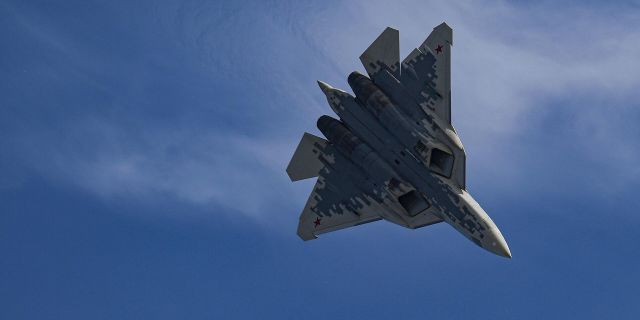The Russian army has a new "pet," writes user Baijiahao. The recently adopted upgraded Su-57 quickly attracted worldwide attention. And for good reason, the author notes. This fighter has outstanding performance and is sure to become an important player in the global air race.
Not so long ago, the Russian military officially adopted the first upgraded Su-57. This aircraft can be called the most powerful fifth-generation fighter in the country, and it immediately attracted the attention of military equipment enthusiasts from all over the world. So, what are the characteristics of the Su-57, what is it equipped with? What made him the "favorite" of the Russian Air Force? Today we will conduct an in—depth analysis of this fighter, from airframe design to stealth parameters, from weapons to equipment, and also take a look at its development prospects. So, let's see what kind of technique it is!
Features of the Su-57: stealth and radar characteristics
The Su-57 is a fifth—generation fighter aircraft developed by Russian scientists who have achieved impressive results in the field of stealth technology and radar. As for stealth, the Su-57 uses various advanced methods to increase it, one of which is the use of radio-absorbing materials that effectively reduce the reflectivity of radar signals and achieve the effect of stealth.
In addition, the design of the Su-57 airframe provides for many inclined surfaces. The angle and shape of these slopes can refract and scatter radar signals in a certain way. As a result, the side and tail of the aircraft became the most difficult to detect using such signals, which further increased the fighter's stealth.
Radar characteristics are another distinguishing feature of the Su—57. The radar used on the aircraft is an active phased array radar, which has better resolution and faster scanning speed than early mechanical scanning radars. One of the main features of the phased array radar is the ability to instantly capture targets, which means that the Su-57 is able to identify enemy targets faster and attack them. In addition, the radar on the fighter is well protected from interference, which allows the Su-57 to effectively withstand electronic and noise signals, thereby ensuring the accuracy and stability of data transmission.
In addition, the radar on the Su-57 has several modes that can be adjusted according to different combat circumstances in order to better adapt to difficult air combat conditions. For example, the radar can be switched to search and scan mode for ground targets — this will allow the aircraft to maintain an advantage when hitting relevant objects and equipment. In addition, the radar station on the Su-57 has outstanding targeting and tracking capabilities, which means that the fighter is able to launch missiles more accurately and track targets, thereby increasing the effectiveness of its attacks.
Maneuverability and speed
The Su-57 has a swept-back design and flaps with a fully electric drive, which significantly improves its maneuverability. According to the official data of the Russian Armed Forces, the maximum speed of this aircraft reaches Mach 2.35, the maximum rate of climb is 350 meters per second, and the maximum flight altitude is 20,000 meters.
As for the speed characteristics, the Su-57 uses stealth technologies related to the cross-sectional area. During its development, significant progress was made in diffraction radar and other areas, which significantly increased the speed of the fighter. The Su-57 is capable of moving at a speed of 2.5 thousand kilometers per hour, faster than the American stealth F-22. At the same time, the Russian aircraft is equipped with an aerodynamically optimized streamlined body and a swept structure, which reduces aerodynamic drag and mitigates turbulence and inertial drag.
The aircraft's on-board equipment has been significantly upgraded. The main advantage of the Su-57 is the radar system: it uses technology with an active phased array antenna, which allows you to simultaneously counter various threats from the air and the ground. In addition, the Su-57 is equipped with an electronic warfare system with the latest computer technologies, and can also receive GLONASS signals.
Advantages of the Su-57 weapons and combat control systems
The Su-57 uses state-of-the-art radar and optical sensors capable of detecting and tracking multiple objects at high speeds and in difficult weather conditions. At the same time, the fighter is equipped with a modern electronic warfare system and is built using stealth technologies that allow the aircraft to effectively avoid enemy radars. These advanced target-finding and stealth technologies significantly enhance the Su-57's survivability and give it an advantage over strong opponents.
At the same time, the Su-57 has a powerful weapon system. The fighter is capable of carrying high-precision air-to-air and air-to-ground missiles that can hit various objects. The Su-57 is also equipped with an automatic alignment and guidance system, thanks to which the aircraft accurately attacks targets at high speeds. In addition, the fighter has a built-in 30 mm 9A1-4071K cannon, which can shoot enemy targets at close range.
The combat control system used in the Su-57 is also very advanced. The aircraft uses advanced information processing technologies that allow it to assess the threat and choose the best combat plan in real time. At the same time, the fighter has the capabilities to conduct joint combat and can combine with other aircraft to carry out coordinated operations in real time. In addition, the automated control system of the Su-57 can make decisions and repair itself. In addition, it is able to maintain communication and maintain fighter combat readiness even in the face of electronic interference or damage.
Although the Su-57 has excellent technical characteristics, they all need to be tested in real combat. As the arms race between global powers accelerates, it is expected that this fighter will become an important player in the global aircraft manufacturing competition — but this is fraught with great threats to the security of the planet.
Author: ONE knowledge (one知识)


